Graceful Cables |
|||||||||||||||||||||||||
 |
 |
||||||||||||||||||||||||
Crocheted jumper with raglan in DROPS Air. The piece is worked top down with cables and relief-stitches. Sizes XS - XXL.
DROPS 210-12 |
|||||||||||||||||||||||||
|
------------------------------------------------------- EXPLANATIONS FOR THE PATTERN: ------------------------------------------------------- CROCHET TIP: The first round of treble crochets is worked from the right side. Finish the round with 1 slip stitch in the 3rd chain stitch at the beginning of the round. Turn the piece and work the next round from the wrong side. Finish the round with 1 slip stitch in the first chain stitch at the beginning of the round. Turn the piece and work the next round from the right side. Continue back and forth like this, with alternately a round of treble crochets from the right side and a round of double crochets from the wrong side. CHAIN STITCH: If you work outermost on the hook the chain stitch will often be too tight; 1 chain stitch should be as long as 1 double crochet/treble crochet is wide . CROCHET INFORMATION: At the beginning of each round of treble crochets work 3 chain stitches; these chain stitches do not replace the first treble crochet. The round finishes with 1 slip stitch in the first treble crochet on the round. At the beginning of each round of double crochets work 1 chain stitch; this chain stitch does not replace the first double crochet. The round finishes with 1 slip stitch in the first double crochet on the round. RAGLAN: Increase on each side of the marker threads in each transition between body and sleeves (= 8 stitches increased on the round). Increase after the marker thread as follows: Work 1 stitch in the first stitch, work 2 stitches in the next stitch (= 1 stitch increased). Increase before the marker thread as follows: Work until there are 2 stitches left before the marker thread, work 2 stitches in the first stitch (= 1 stitch increased), 1 stitch in the next stitch. The new stitches are worked into pattern A.1; i.e. every other round of treble crochets and double crochets (on front and back pieces, the first 4 increases are drawn into each side of diagram A.2). PATTERN: See diagrams A.1 to A.3. DECREASE TIP-1 (for sleeves): Decrease 1 double crochet on each side of the marker thread as follows: Work until there are 3 stitches left before the marker thread, work 2 DOUBLE CROCHETS TOGETHER – read description below, work 1 double crochet in each of the next 2 double crochets (the marker thread sits between these stitches), work 2 double crochets together. WORK 2 DOUBLE CROCHETS TOGETHER: * Insert the hook through the next stitch, pick up the strand *, work from *-* a total of 2 times, make 1 yarn over and pull it through all 3 loops on the hook (= 1 stitch decreased). DECREASE TIP-2 (evenly spaced): To work out how to decrease evenly, count the total number of stitches on the round (e.g. 78 stitches) and divide by number of decreases to be made (e.g. 14) = 5.6. In this example decrease by alternately crocheting together each 4th and 5th double crochet and each 5th and 6th double crochet. ------------------------------------------------------- START THE PIECE HERE: ------------------------------------------------------- JUMPER – SHORT OVERVIEW OF THE PIECE: The piece is worked top down. First work the yoke and then divide for body and sleeves. The neck is worked to finish, where stitches are decreased evenly on the round. The whole piece is worked in the round at the same time as it is turned after each round – read CROCHET TIP. YOKE: Work 78-78-82-86-90-94 chain stitches with hook size 5 mm and Air – read CHAIN STITCH and form them into a ring with 1 slip stitch in the first chain stitch. ROUND 1 (= right side): Work 3 chain stitches – read CROCHET INFORMATION, 1 treble crochet in each of the 78-78-82-86-90-94 chain stitches on the round, finish with 1 slip stitch in the 3rd chain stitch at the beginning of the round, turn the piece – remember CROCHET TIP. Now insert 4 marker threads from the wrong side as follows: Insert 1 marker thread at the beginning of the round (= in transition between back piece and left sleeve), skip the next 8-8-8-10-10-12 stitches, insert a marker thread here (= in transition between left sleeve and front piece), skip the next 31-31-33-33-35-35 stitches, insert a marker thread here (= in transition between front piece and right sleeve), skip the next 8-8-8-10-10-12 stitches, insert a marker thread here (= in transition between right sleeve and back piece), there are 31-31-33-33-35-35 stitches left on the round after the last marker thread. Allow the threads to follow you work onwards. Insert a marker on the front piece in the first row of chain stitches worked. The yoke will be measured from here! On the next round start to increase to RAGLAN – read description above, at the same time as you work pattern as follows: ROUND 2 (= wrong side): Work * A.1 over the first 8-8-8-10-10-12 stitches, the next marker thread sits here, A.1 over the next 3-3-4-4-5-5 stitches, A.2 over the next 25 stitches, A.1 over the next 3-3-4-4-5-5 stitches, the next marker thread sits here *, work from *-* 1 more time on the round. REMEMBER THE CROCHET TENSION! Continue back and forth working the pattern like this and increase to raglan on every round 11-13-15-17-19-20 times and then every 2nd round 4 times in all sizes (= a total of 15-17-19-21-23-24 times) = 198-214-234-254-274-286 stitches. When A.2 has been completed in height, repeat A.3 over A.2 to finished length. When all the increases to raglan are finished, continue with pattern until the piece measures 22-22-24-26-28-30 cm from the neck-edge mid front and down – adjust so the next round is a round of double crochets and is worked from the wrong side. Cut the strand. Now divide the piece for body and sleeves. The transition between body and sleeves is no longer at the marker threads. In sizes XS, S and M start the round 1-1-1 stitch before the first marker thread (seen from the wrong side) and in sizes L, XL and XXL start the round 1-1-2 stitches after the first marker thread (seen from the wrong side). Move the marker thread here and work the next round with pattern as before): Fasten the strand with 1 slip stitch in the first stitch after the new marker thread (= beginning of the round), work 1 chain stitch (replaces the first double crochet on the round) work 6-6-6-8-8-10 loose chain stitches (= in side under the sleeve), skip the next 40-44-48-50-54-56 stitches for the sleeve, work the next 59-63-69-77-83-87 stitches (= front piece), work 6-6-6-8-8-10 loose chain stitches (= in side under the sleeve), skip the next 40-44-48-50-54-56 stitches for the sleeve, work the next 59-63-69-77-83-87 stitches (= back piece) and finish the round with 1 slip stitch in the first chain stitch worked. Body and sleeves are finished separately. Cut the strand. THE PIECE IS NOW MEASURED FROM HERE! BODY: = 130-138-150-170-182-194 stitches. Insert 1 marker thread on each side of the piece, in the middle of the new stitches cast on under each sleeve (= 3-3-3-4-4-5 new stitches on each side of the marker threads). There are 65-69-75-85-91-97 stitches between the marker threads. Start from the right side in the 3rd-3rd-3rd-4th-4th-5th chain stitch mid under the sleeve and work pattern as before – remember CROCHET TIP AND CROCHET INFORMATION. When the piece measures 27-29-29-28-28-28 cm from the division – adjust so you finish after a round of treble crochets, the jumper is finished. The piece measures approx. 52-54-56-58-60-62 cm from the shoulder down. SLEEVES: Fasten the strand in the 3rd-3rd-3rd-4th-4th-5th chain stitch mid under the sleeve and work A.1 in the round as before – remember CROCHET INFORMATION and CROCHET TIP. Work 1 stitch in each of the 3-3-3-4-4-5 loose chain stitches worked under the sleeve = 46-50-54-58-62-66 stitches on the round. When the sleeve measures 4 cm from the division decrease 1 stitch on each side of the marker thread – read DECREASE TIP-1. Decrease like this every 6-5-4-3-2-2 cm (decrease on a round of double crochets) a total of 5-6-7-9-10-11 times = 36-38-40-40-42-44 stitches. Continue working until the sleeve measures approx. 41-41-40-39-37-36 cm – adjust so you finish after a round of treble crochets. Cut and fasten the strand. Work the other sleeve in the same way. NECK-EDGE: Work 1 double crochet in each chain stitch and decrease at the same time 14-12-12-12-12-12 double crochets evenly spaced on the round – read DECREASE TIP-2 = 64-66-70-74-78-82 double crochets. Cut and fasten the strand. |
|||||||||||||||||||||||||
Diagram explanations |
|||||||||||||||||||||||||
|
|||||||||||||||||||||||||

|
|||||||||||||||||||||||||
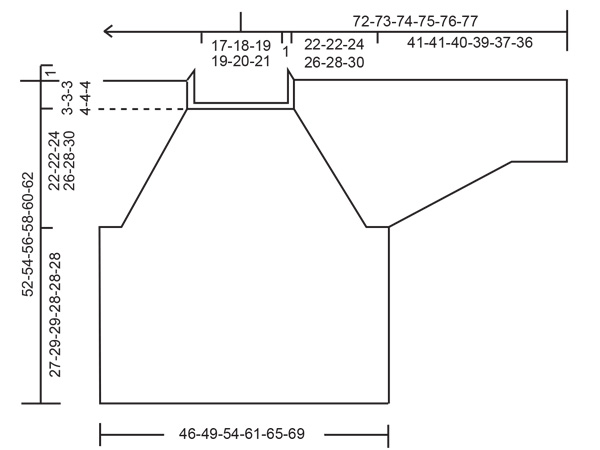
|
|||||||||||||||||||||||||
|
Have you made this or any other of our designs? Tag your pictures in social media with #dropsdesign so we can see them! Do you need help with this pattern?You'll find tutorial videos, a Comments/Questions area and more by visiting the pattern on garnstudio.com. © 1982-2024 DROPS Design A/S. We reserve all rights. This document, including all its sub-sections, has copyrights. Read more about what you can do with our patterns at the bottom of each pattern on our site. |
|||||||||||||||||||||||||









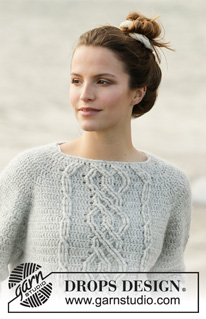
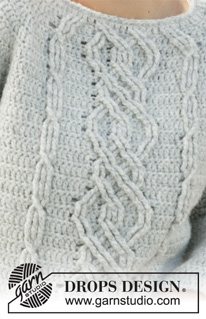













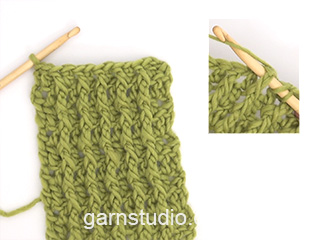




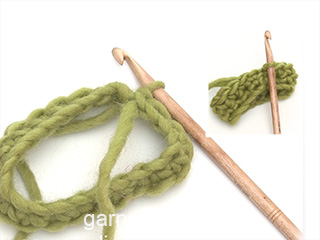







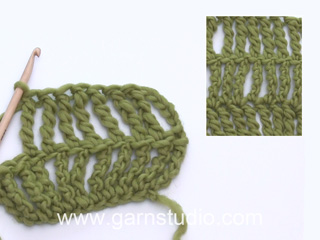












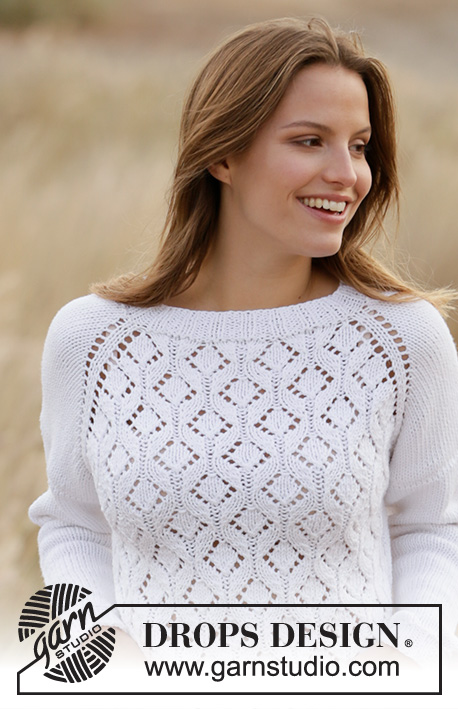






Comments / Questions (31)
Hej. Jeg er har hæklet 2. omgang, men er i tvivl om hvad jeg skal gøre med 3 række, altså efter jeg har hæklet fastmasker med udtagninger. Kan nemlig ikke få det til at passe med de 8 masker af A1, 3 masker af A1, 25 masker af A2 og 3 masker af A1, når der er foretaget udtagninger. Dermed passer det heller ikke med mærketrådene. Håber i kan hjælpe og måske uddybe lidt mere.
22.06.2020 - 10:47DROPS Design answered:
Hej Julie, Har du set videoen, her viser vi fra 2.række i diagrammet:
How to crochet cables and relief-stiches from Garnstudio Drops design on Vimeo.
25.06.2020 - 09:08I love the model but English not my first language and the instructions are very difficult for me. If you want to attract more people,I would suggest video tutorials so that more people can do this and more models.
29.05.2020 - 11:37It would be much easier to understand if you just simply wrote the stitches row by row rather than forcing the person to go back and forth around the page to try and remember what to do. I've managed to get to row 2 but get stuck. How do I proceed? It says to do a1 for 10 stitches (for an XL) but a1 is a row of unfilled ovals which means double crochet? So i did 10 double crochet? Eventually it says to do 25 a2? a2 is a huge section of diagram, which stitch am i doing?! This is really not easy
13.05.2020 - 03:16DROPS Design answered:
Dear Mrs Kayleigh, first row in both diagrams are the one with the arrow, so that on the first row you work 1 dc in the stitch for both A.1 and A.2. So that the first round in pattern is worked as follows: *A.1 (= 10 sts), marker thread, A.1 (= 4 sts), A.2 (= 25 sts on first row = the one with the arrow), A.1 (= 4 sts), marker thread* and repeat from *-* one more time. You can find here how to read diagrams. Happy crocheting!
13.05.2020 - 08:44The same in English: I'm eagerly waiting for Finnish translation for this pattern. When it will be published?
20.04.2020 - 13:53DROPS Design answered:
Dear Elina. Here you can find the finnish translation: https://www.garnstudio.com/pattern.php?id=9537&cid=11 Happy crochetting!
22.04.2020 - 20:08Onko tämä ohje tarkoitus suomentaa jossain vaiheessa? Muilla kielillä ohje on ollut olemassa jo kuukausia.
16.04.2020 - 12:08DROPS Design answered:
Hei, kyseinen ohje on nyt käännetty suomeksi.
13.05.2020 - 17:47Ik kom niet uit de beschrijving. De eerste toer van de pas zijn stokjes, goede kant. Dan een toer vasten, markeerdraden, verkeerde kant. Dan begint het patroon A1 etc. in de 3e toer? En begint in de 3e toer ook de raglan? Ik vind het onduidelijk beschreven.
26.03.2020 - 21:40DROPS Design answered:
Dag Janny,
Nadat je de eerste toer hebt gehaakt voeg je markeerdraden in, zonder te haken, om de raglanlijnen aan te geven. Dan begin je vanaf de 2e toer (op de verkeerde kant) tegelijkertijd met de raglanminderingen en het telpatroon. Dus je volgt het patroon en bij de markeerdraden maak je tegelijkertijd meerderingen. Hoe je meerdert staat boven aan in het patroon. Hoeveel je meerdert staat bij de beschrijving (neem het getal van jouw maat.) De eerste toer in telpatroon A.1, waar een zwarte ster bij staat haak je niet, dit is de toer met stokjes die je zojuist gehaakt hebt en is in het telpatroon getekend om aan te geven hoe je de 2e toer hierin moet haken.
27.03.2020 - 12:32Hej! Vill bara påpeka att det är fel i diagrammet. Ni har missat att spegelvända första flätan på sista varvet i A.3. Nu ser det ut som att den på detta varv ska virkas på samma sätt som den sista flätan.
12.03.2020 - 16:14Es muy chulo, tenía ganas de hacer un patrón así. Gracias
28.02.2020 - 00:27Zijn er meer foto's van het haakwerk Ik kom niet uit de beschrijving. De trui wordt in het rond gehaakt. Wat is nu het verschil met de pas en het lijf. Ik moet 48 steken overslaan voor de mouwen. Moet ik dan eerst afhechten en dan weer aanzetten, anders heb je toch een draad?
27.02.2020 - 09:57DROPS Design answered:
Dag Mariëlle,
Helaas zijn dit de enige foto's die we tot ons beschikking hebben. De pas is waar het lijf en de mouwen in een stuk in de rondte worden gebreid. Het lijf is het gedeelte vanaf de oksels, dus zonder de mouwen. Je haakt dus een aantal lossen en slaat de steken van de mouwen over en gaat gelijk verder met de volgende steek op het lijf, zonder een draad o.i.d. Hierdoor ontstaat a.h.w. een stukje korte mouw of armsgat. De mouw haak je hier later aan.
28.02.2020 - 19:22IO SONO UNA PRINCIPIANTE E NON RIESCO A SEGUIRE LO SCHEMA MI POTRESTE DARE UN AIUTO?NELLA LEGENDA LA MAGLIA MASSA VOLEVA ESSERE UNA MAGLI A BASSA?
08.02.2020 - 18:27DROPS Design answered:
Buongiorno Paola. Abbiamo corretto il testo: è una maglia bassa. Buon lavoro!
08.02.2020 - 20:57